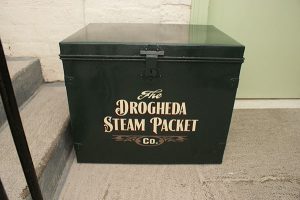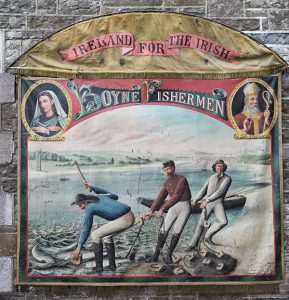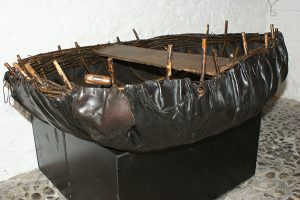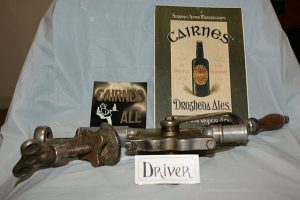MUSEUM EYE: Drogheda Museum
Published in Issue 2 (March/April 2018), Reviews, Volume 26Governor’s House, Millmount, Drogheda
www.droghedamuseum.ie, info@droghedamuseum.ie
By Tony Canavan

Above: Memorabilia from the Drogheda Steam Packet Company reminds us that Drogheda has long been a busy port.

Above: The Boyne Fishermen’s banner provides a snapshot of mid-nineteenth-century Drogheda, with the famous railway viaduct in the background.

Above: A Boyne coracle—these circular cowhide boats were a common sight on the Boyne until recently, used by fishermen and farmers.

Above: There are examples of advertising for the local Cairnes Ales and other memorabilia on display, such as whiskey jars, pots, bottles and soda siphons, as well as a set of cooper’s tools.
On the ground floor is the reception. The staff here are friendly and happy to give a tour of the museum. Nearby is a room dedicated to the 1916 Rising. Millmount played a role in this era and was damaged by Free State artillery during the Civil War. Of more local interest is the banner room, featuring hand-painted banners, some of silk, representing the various trades that were once prominent in the town. The Shoemakers’ banner is mentioned as having been carried to the Hill of Tara for Daniel O’Connell’s famous rally in 1843. It features St Patrick trampling on snakes with his handmade Drogheda shoes. Look out for the Boyne Fishermen’s banner, which provides a snapshot of mid-nineteenth-century Drogheda. The famous railway viaduct and townscape can be seen in the background, while a man glides serenely past in a rowing-boat. Two men are hauling ashore a net loaded with fish, and a third man stands over it with a club raised aloft. This club was nicknamed ‘the priest’, as it administered the ‘last rites’ to the struggling salmon.
Downstairs in the basement is an Aladdin’s cave of local history. One space is taken up with telephonic artefacts, from a switchboard and old phones to cables and call cards (prepaid cards for use in Telecom Éireann phone boxes like the one outside the museum, now made obsolete by mobile phones). Elsewhere is a kitchen featuring pots, pans, an old fireplace, chairs, smoothing-irons, carpet-beaters and even a settle bed. Further along is a display of churns and other paraphernalia for making butter. Nearby there is an example of bog butter, linking with the archaeological artefacts on display, mainly fragments of earthenware and carved stonework from different eras. Finally, do not leave without examining an original Boyne coracle. These circular cowhide boats were a common sight on the Boyne until recently, used by fishermen and farmers.
Another room has a collection of domestic silverware but is mainly dedicated to the once-booming linen industry in Drogheda. In the nineteenth century many weavers were based there, and linen works survived into the twentieth century. Across the corridor is a geology room displaying samples of rock representing millions of years of history. Perhaps of more interest is the display of silver trophy cups from various sports but mainly rowing, which has always been strong in Drogheda. A local hero is honoured in one cabinet with the official vest and boots worn by Anthony ‘Socks’ Byrne when he won a bronze medal for boxing in the 1956 Melbourne Olympics. Local soccer heroes, like Alan Kelly, are also remembered.
On the way back downstairs is an exhibition dedicated to seventeenth-century wars. Many of the key events of these conflicts happened in or near Drogheda, such as its siege by Oliver Cromwell and the 1690 Battle of the Boyne. Portraits, maps, swords and so on tell the story of this era of conflict and Drogheda’s role in it. Despite its size and antiquity, Drogheda does not feature much in the public imagination. Yet, as the museum illustrates, it has an important and interesting history.
Tony Canavan is editor of Books Ireland.
















